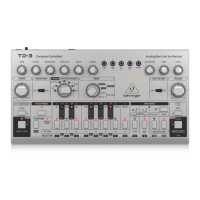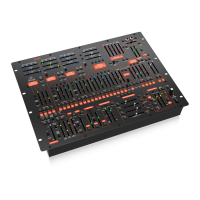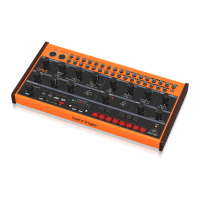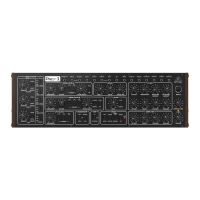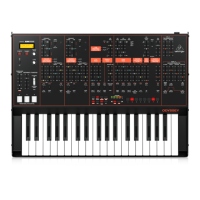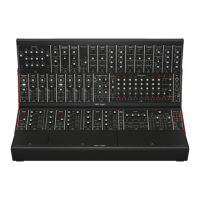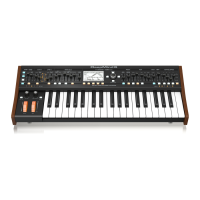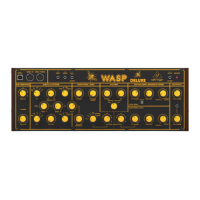25 NEUTRON User Manual
13. Glossary
NEUTRON GLOSSARY
This glossary provides an explanation of useful symbols, terms and abbreviations.
32'/16'/8': Used to describe the range of an oscillator, this term originates from
pipe organs. for example, an 8' pipe is one octave higher than an 16' pipe.
ADSR: Attack, Decay, Sustain and Release, an envelope with four stages.
Aftertouch: Aftertouchis MIDI data sent when pressure is applied to a keyboard
after the key has been struck, and while it is being held down or sustained.
Attack Time: The rst stage of an ADSR envelope, used to control the initial
part of a sound. Specied as the duration of time for an envelope to reach the
maximum level after it has been triggered on by a key press or gate signal.
Attenuate: To reduce the level of a signal.
Band Pass Filter (BPF): A lter that passes frequencies within a certain range
and rejects (attenuates) frequencies outside that range.
Bipolar: a signal that includes positive and negative values.
Cent: Unit of measurement for pitch tuning. There are one hundred cents in a
semitone.
Control Voltage (CV): A voltage signal used to control a parameter. Was
common on synthesizers before MIDI and is now found mostly on modular
synthesizers.
Cut-O Frequency: The frequency which the lter is set to. Beyond this
frequency the sound is cut depending on the type of lter used. See LPF, BPF and
HPF.
dBu: A unit of measurement of sound used in professional audio.
DC Oset: A DC voltage which is added to an AC waveform.
Decay Time: The second stage of an ADSR envelope. Specied as the duration of
time for an envelope to reach the sustain level after the maximum level has been
reached during the attack stage.
Digital Audio Workstation (DAW): A computer-based recording system.
More commonly used to describe the software package used to record,
process and mix.
Distortion: An eect which adds harmonic content to a signal.
Drive: Provide a gain boost to produce soft clipping.
Eect: One of a number of audio processes that can be applied to a signal to
modify it, such as reverb, anging, phasing, delay etc.
Envelope Generator (EG): An envelope signal which can be adjusted to a
specic shape in order to control the way a sound behaves over time.
Feedback: A loop created between an audio input and an audio output of an
audio circuit, system or processing block.
Filter: A device that attenuates certain frequencies while letting other
frequencies through. Using a lter to reduce harmonics, changes the timbre or
color of the sound.
Frequency Modulation (FM): Using one frequency to modulate another
frequency's pitch. When the modulation source is in the audio range, it can be
perceived as a change in the timbre or color of the sound. FM can be used to
create a wide range of rich and complex sounds and is often described as having
a clear and distinctive timbre.
Frequency: Measured in Hz.
Gain: The amount of signal level increase provided by an amplier stage.
Gate (Synthesizer): A signal used to trigger an event, such as a note or
an envelope.
Harmonics: A series of integer-related sine waves at varying levels creating
dierent timbres. Waveforms (other than a pure sinusoidal) generate various
harmonics which help dene the character of the sound.
High Pass Filter (LPF): A lter that attenuates lower frequencies below the
lter cuto point, leaving the higher frequencies unaected.
Invert: To change it to its opposite, e.g. change a positive value becomes
negative etc.
Keyboard Tracking: Allows the control signal from received midi notes to
adjust another parameter. The Neutron uses keyboard tracking to move the lter
cut o frequency relative to the played note.
Kilohertz (kHz): A unit of frequency equal to one thousand cycles of a wave
per second.
Level: Used to describe the magnitude of a sound, often relative to an arbitrary
reference.
Line Level: A nominal operating level used by audio equipment.
Low Frequency Oscillator (LFO): An oscillator that commonly runs at a very
low speed and is used to modulate another parameter.
MIDI (Musical Instrument Digital Interface): A technical standard that
describes a protocol, digital interface and connectors and allows a wide variety of
electronic musical instruments, computers and other related hardware/software
devices to connect and communicate.
MIDI Clock: A clock signal which is broadcast over MIDI to ensure that devices are
synchronized. Also known as MIDI Beat Clock or MIDI Timing Clock.
MIDI Message: Data or information transmitted from one MIDI device to
another.
MIDI Gate: The MIDI Gate typically controls the note on-o.
Mix: The balance of level between one signal and another.
Modulation: The process of controlling one or more properties (destinations) of
a signal using another signal (source).
Modulation Wheel (Mod Wheel): A wheel located to the left of a keyboard
that allows you to change specied parameters in real-time.
Monitors: Studio quality loudspeakers, providing an accurate representation of
the audio signals.
Mono: Signal channel audio.
Monophonic: Only one note can be played at any given time, as there is only a
single voice.
Mute: Function that allows a signal to be silenced.
N/A: An electronic device which generates a periodic signal .
Noise: A circuit that produces white noise.
Note-Priority: Determines which note is played when more notes are held
simultaneously than the number of available voices (often: low/high/last).
Octave or Oct: Unit of measurement for pitch. Every time the frequency of a
waveform doubles, the pitch increases by one octave.
Oscillator: An electronic device which generates a periodic signal used to form
the basis of a synthesizer program.
Output: The signal sent out by a device or process. Also used to describe the
physical socket where a signal leaves a device.

